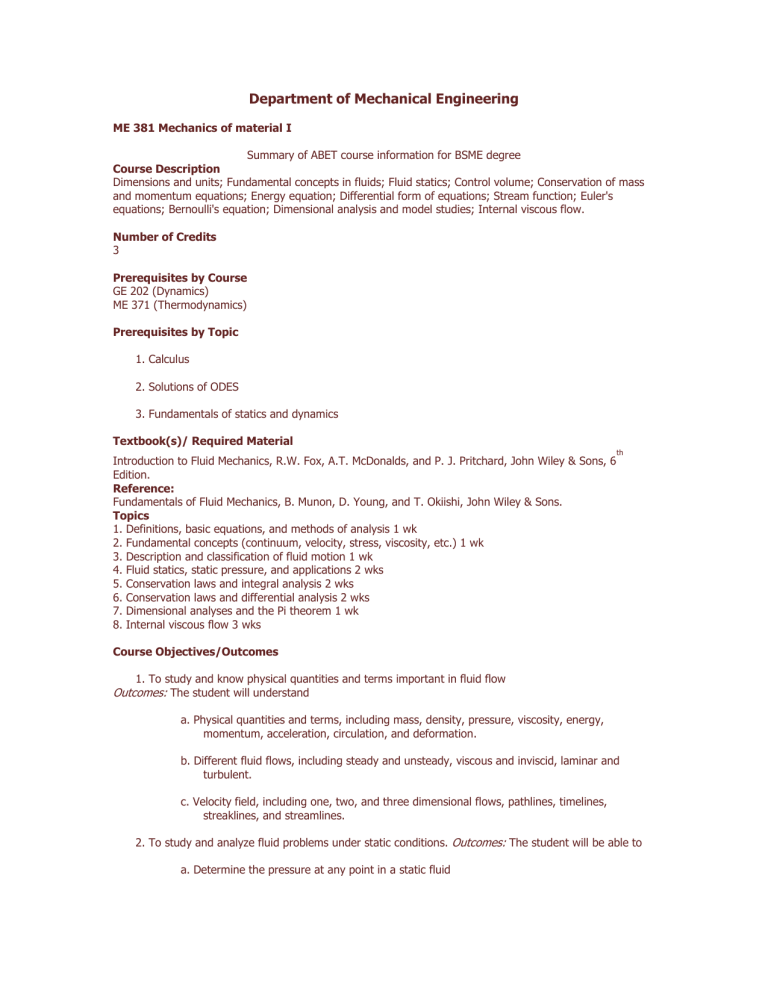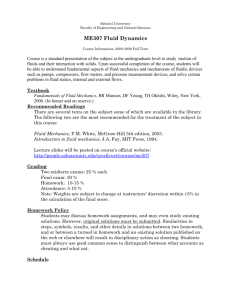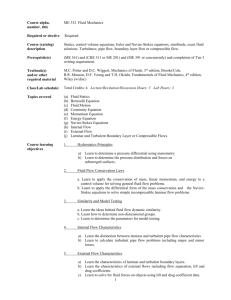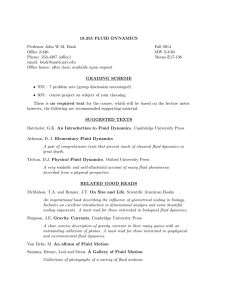Department of Mechanical Engineering ME 381 Mechanics of

Department of Mechanical Engineering
ME 381 Mechanics of material I
Summary of ABET course information for BSME degree
Course Description
Dimensions and units; Fundamental concepts in fluids; Fluid statics; Control volume; Conservation of mass and momentum equations; Energy equation; Differential form of equations; Stream function; Euler's equations; Bernoulli's equation; Dimensional analysis and model studies; Internal viscous flow.
Number of Credits
3
Prerequisites by Course
GE 202 (Dynamics)
ME 371 (Thermodynamics)
Prerequisites by Topic
1. Calculus
2. Solutions of ODES
3. Fundamentals of statics and dynamics
Textbook(s)/ Required Material
Introduction to Fluid Mechanics, R.W. Fox, A.T. McDonalds, and P. J. Pritchard, John Wiley & Sons, 6 th
Edition.
Reference:
Fundamentals of Fluid Mechanics, B. Munon, D. Young, and T. Okiishi, John Wiley & Sons.
Topics
1. Definitions, basic equations, and methods of analysis 1 wk
2. Fundamental concepts (continuum, velocity, stress, viscosity, etc.) 1 wk
3. Description and classification of fluid motion 1 wk
4. Fluid statics, static pressure, and applications 2 wks
5. Conservation laws and integral analysis 2 wks
6. Conservation laws and differential analysis 2 wks
7. Dimensional analyses and the Pi theorem 1 wk
8. Internal viscous flow 3 wks
Course Objectives/Outcomes
1. To study and know physical quantities and terms important in fluid flow
Outcomes:
The student will understand a. Physical quantities and terms, including mass, density, pressure, viscosity, energy, momentum, acceleration, circulation, and deformation. b. Different fluid flows, including steady and unsteady, viscous and inviscid, laminar and turbulent. c. Velocity field, including one, two, and three dimensional flows, pathlines, timelines, streaklines, and streamlines.
2. To study and analyze fluid problems under static conditions.
Outcomes:
The student will be able to a. Determine the pressure at any point in a static fluid
b. Determine the static forces on any surface or body c. Analyze the stability of a floating body
3. To study and analyze fluid problems in motion.
Outcomes:
The student will be able to a. Use continuity, momentum, and energy principles to analyze fluid flow problems b. Use manometers to measure pressure c. Distinguish flow behavior between laminar and turbulent flows and use the correct principles for analysis d. Use basic laws of physics while making reasonable simplifying assumptions to solve some practical fluid flow problems.
4. To study dimensional analysis and Similitude.
Outcome:
The student will be able to a. Construct non-dimensional parameters using the PI theorem b. Solve fluid flow problems using similarity c. Conduct numerical and lab experiments using non-dimensional parameters
This course shares the following ME Program Objectives/Outcomes:
1. To be able to identify, formulate and solve engineering problems [e]
2. To apply the fundamental knowledge of science, mathematics and engineering principles [a]
3. To be able to use the engineering skills and tools in engineering practice [k]
4. To be able to communicate effectively [g]
5. To be able to work with, and in specialized applications of, computers in the performance of job functions [k]
Design Content: None
Lectures: 100 %
Laboratory Portion: None
Assessment Tools:
Homework: 10 %
Midterm Exam: 40 %
Final Exam: 50 %
Estimated ABET Category Content:
Mathematics and Basic Science: 0 credit units or 0%
Engineering Science: 3.0 credit units or 100%
Engineering Design: 0 credit units or 0%
Prepared by
Dr. Abdullah Nuhait [anuhait@hotmail.com]
Dr. Khalid Alammar [alammar@ksu.edu.sa]
Date: Sept 2005
Revised:




